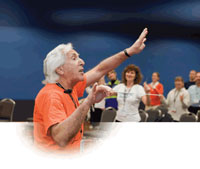
In 2002, at age 68, David Dworkin founded a unique “symphonic aerobics” program, which has since become internationally recognized. Conductorcise®—a Sound Workout for Mind, Body and Soul—is “a symphony performance, music history lesson and aerobics workout all rolled into one,” suggests The Times-Picayune, New Orleans’ newspaper.
A graduate of The Juilliard School and Columbia University, Dworkin channeled his passion for music and physical fitness into this innovative program. Conductorcise, it turns out, is the next act in his long and distinguished career as a symphony conductor, clarinetist and music educator. In the last seven years, he has traveled widely to lead Conductorcise workouts for audiences of all ages and abilities.
Participants enjoy “an invigorating upper-body workout, learn basic conducting techniques, improve listening skills, and find out about the lives and work of the great composers,” Dworkin explains. He applies the same basic approach to each Conductorcise session, but tailors the challenges and level of effort for each group. Sessions for healthy older adults can be longer and more vigorous, with some lower-body movements, for example. With individuals who have Alzheimer’s disease, Dworkin chooses slightly shorter classical musical pieces that participants are likely to know, helping to connect them to the activity.
In each session, the maestro brings what he calls the “energy, motion and magic of music” to participants, who wave batons along with him as they move to the music of Tchaikovsky, Mozart and more. Interestingly, Dworkin has found that, among the groups he has led, participants with Alzheimer’s and other dementias respond with intense interest to the workout. In the end, “Conductorcise is extremely effective in getting participants enthused about classical music, and keeping them engaged, thinking and in motion,” he says.
Dworkin sees conducting as “a physical and a spiritual experience.” The physical benefits include, among others, increased blood flow, upper-body stretching and strengthening, improved cardio endurance, and the growth of new brain cells. That means Conductorcise participation can help improve physical health and function, while enhancing intellectual, social, spiritual and emotional wellness.
“Conductorcise is a winner, because many people don’t think they are exercising when performing the program,” Dworkin observes. “Not only are they moving their bodies in a way many have never done, but they are also stimulating their brains by being made aware of colors, conversations and rhythms in the music.”
Five key lessons learned in creating a classical music fitness experience for older adults
1. Prepare. It’s just like music or anything else in communication. Go over and over and over your program. Ask yourself, Is this the best way I can do it? Don’t be afraid to change, add, etc.
2. Reach out to all. Learn from colleagues. Reach out to physicians (both alternative and traditional), social workers, wellness professionals.
3. Give of yourself 150% all the time.
4. Never lose your sense of humor. Laugh at yourself. Make people smile.
5. Passion. You must have a passion and love what you are doing.
What are you doing to make your programs a unique, fun experience?





